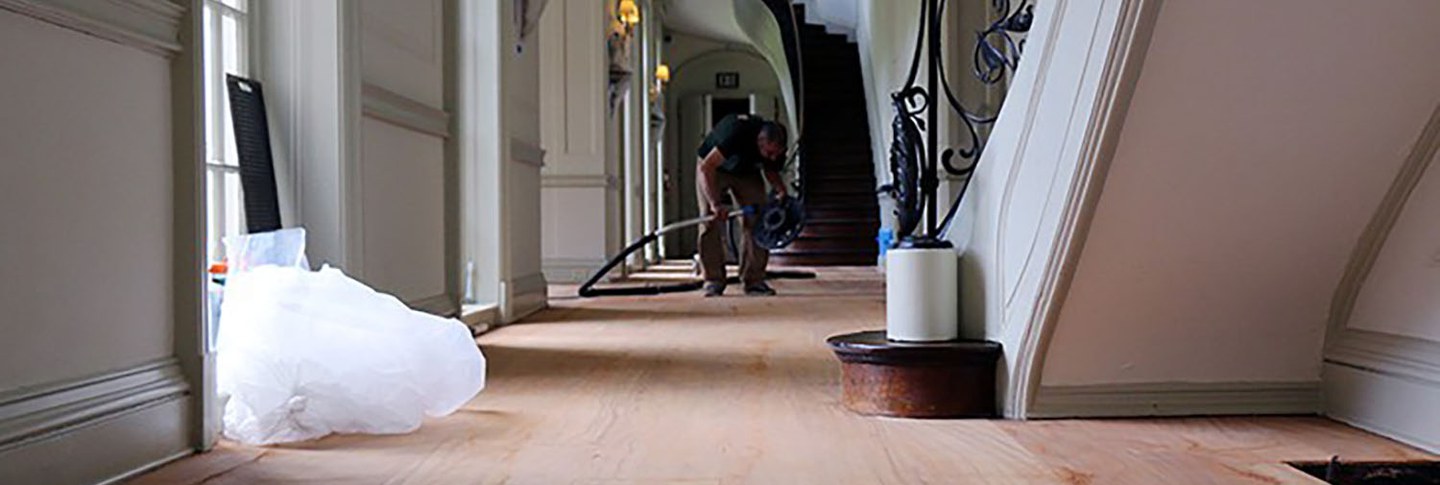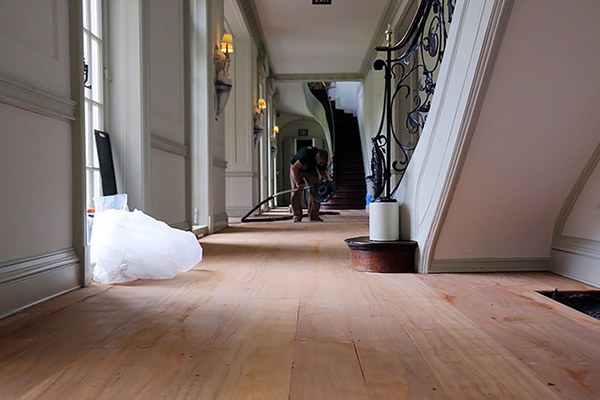Most visitors to Dumbarton Oaks come to admire the art in gallery vitrines or the ornate furnishings lining the halls of the historic mansion, and likely spare little thought for what’s beneath their shoes as they pass through Mildred and Robert Woods Bliss’s former home. Yet the original flooring of the Main House is a historic artifact in itself, and one that Dumbarton Oaks’ facilities team is working to preserve and protect.
The team is currently in the midst of a multiphase project to refinish the floors of the Main House, including several museum galleries, the Founders’ Room, and the Oval Salon. Director of Facilities Alan Dirican says that the process, which involves a light sanding to remove an old coat of finish and then the application and overnight drying of the new coat, takes two days for each room.
The refinishing project, which is taking place in a space that functions as a museum, historic home, and workplace, involves a variety of logistical challenges. The facilities team worked with museum staff to develop the best protection possible for the building itself and the objects within it. “In those areas we have furniture, we have paintings, and our museum staff removed them before we got into the space. Obviously whenever you’re in a museum environment, the biggest challenge is to move the objects out of the space, or to protect the objects in their places,” says Dirican. “Sometimes that’s more costly or more time-consuming than the actual work itself.” The facilities staff also used an all-natural, museum-grade wood finish that was carefully tested to ensure that it would give off no vapors that could adversely affect the objects in the galleries.
Preserving these floors is particularly important because of the type of wood used in the mansion. According to Archivist and House Collection Manager James Carder, the floors, installed in 1922 and 1923, are acacia koa, a tree native to Hawaii and also known as “Hawaiian mahogany” for its distinctive sheen and rich red or golden-brown color. Prized today for furniture and decoration, the wood was used by early Hawaiians to craft dugout canoes and surfboards. However, after nearly a century since the original installation of the floors, native stands of koa have suffered extensively from land clearing, poor cutting practices, and destruction by animals and insects. Increasingly rare, koa today is one of the most expensive types of wood in the world. Indeed, according to Carder, even the Blisses used it only in limited quantities. “The floor boards are what is called ‘engineered,’” he explains. “They have a quarter-inch of koa laminated to another wood.” The floors in the historic mansion would be very costly to replace today, making their preservation critically important.
Conserving the precious floors is only one part of the facilities team’s ongoing efforts to protect the brick-and-mortar legacy left to future generations by the Blisses. Dirican says that next on the agenda is the conservation of the mansion’s roofs and lighting upgrades for several of the galleries as his team continues to work behind the scenes to maintain and modernize the historic mansion and its museum spaces.

